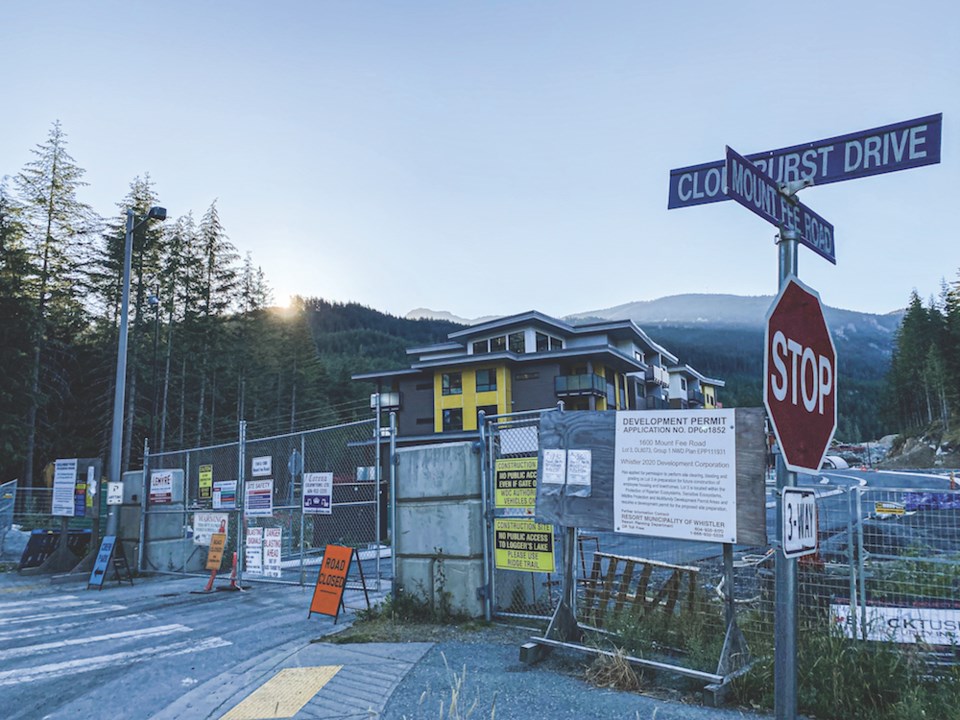Whistler cannot stop building affordable housing—that was the key message Whistler Development Corp. (WDC) president Eric Martin delivered to mayor and council during a Sept. 6 update to mayor and council on Cheakamus Crossing Phase 2.
While material costs, interest rates and general inflation have all been on the rise as of late, Martin still believes now is the time to act on housing.
“[The housing crisis] is a very broad issue and a broad problem, and we can’t stop building,” he said. “We just cannot stop building, so we have to find a way.”
Cheakamus Crossing Phase 2 has been the cornerstone project for the current mayor and council, and has made solid progress in the face of challenging odds.
“The first two buildings are going very well. We’re pretty much done,” Martin said. “We’re pretty much on schedule and within our budget for those two buildings, which is great.”
The first of the two—which together contain 100 units of for-purchase housing—is ready for occupancy, with the second on track for completion in December and move-in in January, Martin said.
Still, Martin doesn’t believe the Resort Municipality of Whistler (RMOW) should rest on its laurels, but instead continue building, as costs are only expected to increase down the road.
“[Rising inflation and interest rates have] not affected the current project, but will obviously affect any of the future projects,” he said.
“Obviously, material cost increases, supply chain issues, [and] some labour shortages, although generally speaking in Whistler, we haven’t seen that so much because we had our contracts locked in over a year ago, so that hasn’t been a big impact.”
High interest rates will be a significant factor in long-term financing for new buildings, and for residents attempting to secure mortgages, Martin said.
“It’s a big factor for people having to acquire mortgages and be able to qualify and make payments,” he said. “It doesn’t have a lot of construction impact, but it definitely does have a longer-term impact.”
According to Martin, construction costs have increased by 10 to 15 per cent in recent months, which in turn contributes to higher rents.
While Cheakamus Phase 2 has helped reduce the Whistler Housing Authority’s (WHA) waitlist, Martin’s report highlighted that there are still many people on the list.
According to the report, there are 506 people still on the WHA’s rental waitlist, with single-person households making up the majority (55 per cent), followed by couples without children (26 per cent), families with dependents (17 per cent) and groups of unrelated adults (two per cent).
The report also noted that seasonal and temporary foreign workers who are not permanent residents of Canada do not qualify for WHA rentals, which further hampers Whistler’s ability to house its workforce.
“People aren’t on the waitlist because they’re maybe two- or three-year employees or are seasonal or whatever; we’re not addressing them because they’re not on the waitlist,” Martin said.
“A lot of our RCMP and [other key roles in town] aren’t on the waitlist because they feel they’re probably not going to be here long enough.”
With two buildings nearing completion, work is now underway on the next Phase 2 project, Martin added: two rental buildings containing 69 units in total, made up of a mix of unit types “to appeal to a wide variety of households.”
The recently reinvigorated Whistler Valley Housing Society (WVHS) has signed a letter of intent to purchase one of the buildings, while the WHA is also doing a feasibility study to determine if it has the capacity to finance one of the buildings.
According to the report, both the WVHS and WHA are looking at financing options for the new builds. With that in mind, the WDC’s project plan “provides a budget for each building and allows WDC to proceed with either building and theoretically both buildings if for some reason neither the WVHS nor WHA choose to proceed,” the report said.
WDC anticipates continued price increases for materials like lumber, steel and concrete, but expects prices to stabilize by early-to-mid 2023.
So the developers are taking a cautious approach to financing the new builds, opting for an approximately 15-per-cent larger contingency fund than was used for the previous builds.
The two buildings on Lot 1 cost $35,599,024, including a $2,383,673 contingency fund as of April 2022. The buildings planned next door on what’s known as Lot 2 are estimated to cost about $14 million each.
If everything goes according to plan, Martin expects the development to move forward by early next year.
“We’ll probably be out to bid on the next buildings by the end of the year,” he said. “We’ll finish our design work this fall and will bid everything, and we’ll see where interest rates are, and we’re looking at starting the first building on Lot 2 in early spring next year.”
But for Martin, it all comes back to his one key message.
“If it costs more, it will be a little more expensive for end users, and we have to put more money into capital,” he said. “But we can’t stop, because costs are not going to go down.”
Building more housing and advancing Cheakamus Phase 2 being one of his key platform planks in the 2018 election, it’s no surprise Mayor Jack Crompton is enthusiastic to see the progress made so far.
“It’s really exciting to see people moving in. There is a tremendous amount of work to do moving forward, and we’ve got a great team of people to do that,” Crompton said at the Sept. 6 council meeting.
“Challenging economic conditions are why I am so enthusiastic about the WDC and its work for us. We have some of the leading experts in property development in British Columbia, working at no cost for our municipality; it’s a really big deal.”



